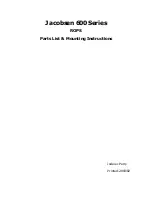
RP0176-2003
12
NACE International
where:
σ
= standard deviation for the i
m
data,
T
d
= design life
c = safety factor multiple on
σ
, and
a and b are constants.
Values for a, b, and
σ
were determined for cold
and warm water locations as listed in Table 1. The
magnitude for c is selected based on the factor of
safety that is judged appropriate with credit being
given for system redundancy. It was shown that
the design i
m
values in Appendix A for cold water
locations correspond to c ~ 1, whereas the
Appendix A current densities exceed the i
m
pro-
jected by Equation (1) for warm water locations
even with c = 2, which encompasses 97.5% of the
data.
Table 1: Suggested Design Parameters for Equation (1)
Warm/Shallow Parameters
Cold/Deep Water Parameters
σ
0.233
0.229
a 3.130
2.820
b -0.410
-0.226
5.6.2.2 Typical mud zone protective current densi-
ties are 10 to 30 mA/m
2
(1 to 3 mA/ft
2
).
5.6.2.3 An allowance should be included in the
total design current requirements to compensate
for the current load imposed by the well casings
below the mudline. Values typically range from
1.5 to 5 A per well. For tension leg platform (TLP)
and subsea production templates the well casings
may be coated or cemented from total depth (TD)
to the seabed, and thus greatly reduce the bare
steel areas that draw current. In these cases con-
sideration for the reduced surface area should be
made, which may justify a reduction in the current
allowance per well.
5.6.2.4 An allowance should be included in the
total design current requirements to compensate
for the current load imposed by pilings below the
mudline. Values typically range from 1.5 to 5 A
per piling. For subsea templates, this current de-
mand may control the design.
5.6.3 Allowance for coatings, if any, on submerged
portions of the structure.
5.6.3.1 In the past, conventional protective coat-
ings (other than anode shields) were seldom ap-
plied to structures below the splash zone. How-
ever, increased current requirements and anode
weight restrictions can affect the decision to coat
complex structures to be installed in deeper waters
with higher current density requirements, in shield-
ed areas such as large conductor bundles, and/or
on structures with extended design lives.
5.6.3.2 The current demand of a coated structure
increases with time as the coating deteriorates.
Enough CP capacity should be provided to main-
tain protection as the coating deteriorates. Current
demand may increase more or less rapidly than a
visual inspection of the coating deterioration indi-
cates.
5.6.3.3 Calcareous coatings, formed on the struc-
ture members by the application of CP current,
reduce the current density required to maintain
protective potentials and also improve current dis-
tribution (see Paragraph 5.6.4). Organic coatings
also promote the formation of a dense calcareous
deposit at coating holidays and bare areas be-
cause the initial current density may be relatively
high at such locations. However, the solubility of
potential film-forming calcareous deposits normally
increases with decreasing temperature such that
colder waters might not allow the formation of a
protective calcareous coating or could require
higher initial current density to achieve polari-
zation.
5.6.4 Efficiency of current distribution
5.6.4.1 Current distribution efficiency can be im-
proved by use of a greater number of anodes of
lower individual output. Current distribution can
also be improved by using a coating on the struc-
ture.
5.6.4.2 Galvanic anode systems, being made up
of numerous distributed, small current sources
(typically from 3 to 6 A each) achieve maximum
efficiency of current distribution. When these
anodes are mounted at least 30 cm (12 in.) offset
from the structure members, a uniform current dis-
tribution is normally assumed for design purposes.
5.6.4.3 Impressed current anodes, being fewer in
number and designed for larger current outputs
than galvanic anodes, normally have a reduced
current distribution efficiency. These anodes may
be designed to discharge from 30 to more than
200 A each. The high current output usually re-
sults in overprotection of the nearest structure sur-
faces. To compensate for the inefficient distribu-
tion of current, an efficiency factor (usually in the
range of 67 to 80%) should be used. The CP sys-
tem should be sized to provide 1.25 to 1.50 times
Summary of Contents for CP 1
Page 1: ...CP 1 Cathodic Protection Tester Course Manual February 2005 NACE International 2000 ...
Page 265: ......
Page 266: ......
Page 267: ......
Page 268: ......
Page 301: ...RP0169 2002 32 NACE International ISBN 1 57590 035 1 ...
Page 535: ...TM0101 2001 24 NACE International ISBN 1 57590 137 4 ...
















































